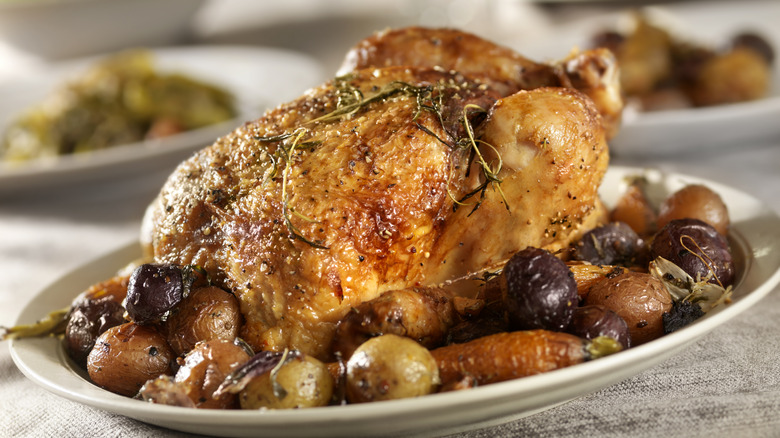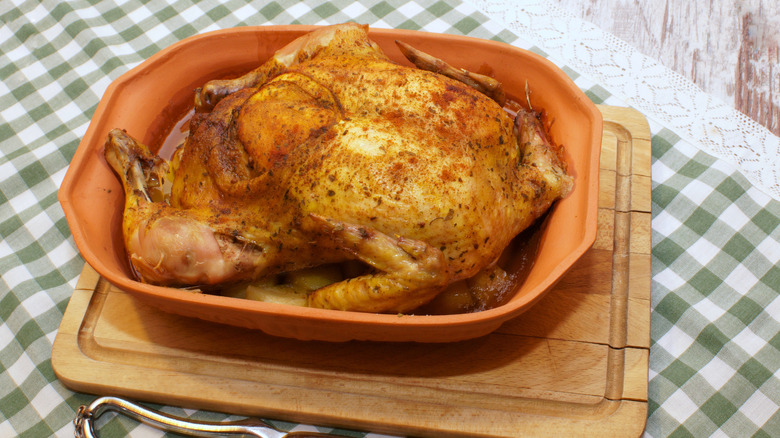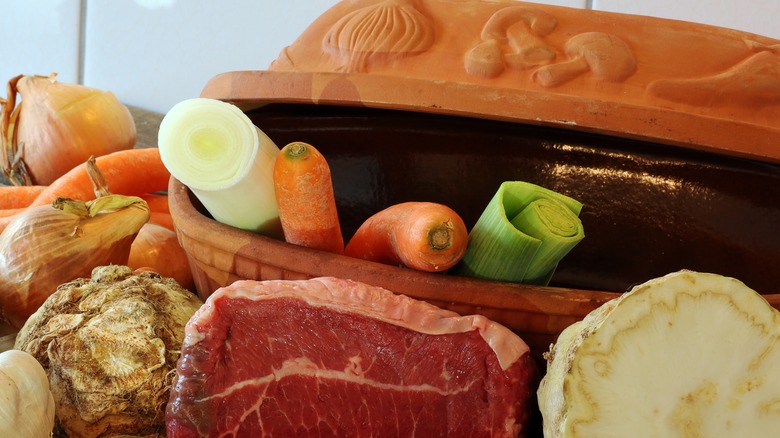Clay Pans Are Key To Out-Of-This-World Roasted Chicken
A humble yet crowd-pleasing meal, roast chicken is a simple and satisfying dinner. However, while it doesn't require any fancy techniques, it's notoriously hard to perfectly roast a bird. If you take your eye off the ball, you may end up with dry, chewy meat that's a disappointment as a dinner and even more dismal as leftovers. There's a foolproof way to avoid this fate, and it lies in the use of an ancient cooking technique. Meet the Römertopf pot, a piece of German cookware that can revolutionize your roast chicken.
A similar vessel to a Moroccan tagine or a Japanese donabe, this clay baking dish is beloved for its amazing slow-cooking qualities. Unlike the aforementioned pots, the Römertopf (meaning "Roman pot" in German) is classified as a wet clay cooking vessel. Sporting a rust-red terra cotta hue, the lid and/or pot is meant to be soaked in water before it's used for baking food. Much of the magic lies in the large amount of moisture that the clay material absorbs, which transforms into steam during the cooking process. This produces food that isn't so much braised or roasted but steamed, and can yield a tender bird full of delicious chicken juices.
When using this pan, you can even technically overcook your chicken without really drying it out. When it's all said and done, the Römertopf will ensure the juiciest roast chicken you've ever had.
The history behind the Römertopf
Clay pots are some of the oldest cooking vessels in existence. Thousands of years ago, the Etruscans used unglazed clay cooking pots that the Roman empire quickly adopted for their own culinary uses. This is considered the ancient forefather to the German Römertopf pot. In China during the Han dynasty, a similar clay dish called the sandy pot was used for their version of wet clay cooking. Though these clay dishes worked extremely well, they became passé when metal became the medium of choice for pots, as it heated up much faster than clay.
Still, clay remains a superior material for slow-cooking methods like roasting and braising, as it maintains a nice, even heat very well. Even our modern-day slow cookers make use of ceramic basins, which are made of clay, to hold and heat food. In 1967, the Römertopf company unveiled its namesake pot, a two-piece oval baking dish made with high-quality German clay. The game-changing detail to this pot? While the exterior and lid remained unglazed, the base interior had a glass glaze so that clean-up was infinitely easier.
Tips for using your Römertopf
If you get your hands on a Römertopf pot, there are a few factors to pay attention to. First, consider the size of the pot. Most Römertopf products are offered in 3-quart and 4.2-quart sizes, which would accommodate a chicken of 5 to 6 pounds, plus vegetables and other aromatics. However, there are larger Römertopf pots that can handle larger chickens.
Next, remember to always soak the lid of the pot so the food steams properly. The first time you use the pot, soak the lid for 40 minutes. After that, soak it for 15 minutes each time you use it. Since clay is sensitive to drastic changes in temperature, begin your dish in a cold oven, allowing it to preheat with the pot of food already inside. Also, invest in a heat-safe trivet to put your pot on when cooking is finished, as the hot clay dish could split if set on a cold countertop.
A wet clay cooking method will also affect your ingredients. While some roast chicken recipes will have you coat your bird with butter or oil, the Römertopf eliminates the need for this, as the bird will be perfectly juicy without it. Finally, use a thermometer to gauge when you should remove the lid — which is when the meat's internal temperature is at 125 degrees Fahrenheit – so the chicken can get a golden crust in its last 15 to 20 minutes of cooking.



